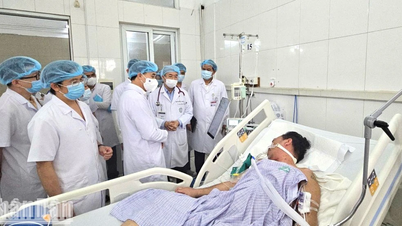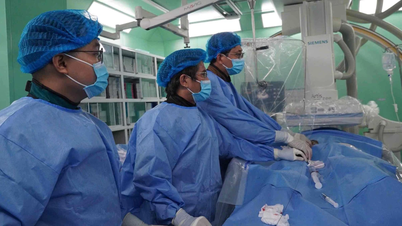Patient LMS, male, 18 years old, first-year student at a university in Ho Chi Minh City. On December 11, 2023, due to a personal grudge arising from a football match organized by the school, immediately after the match ended, the victim was stabbed from behind in the right neck area with a sharp knife by a male student from the same school. The wound caused a lot of bleeding, was temporarily bandaged by teachers and classmates and taken to the emergency room at Military Hospital 175.
Upon receiving the victim, the hospital immediately activated the red alert procedure (code red), doctors from many specialties quickly arrived, examined the wound and determined that the patient had a punctured large blood vessel in the neck, the bleeding was still active, and the prognosis was critical. The doctors urgently bandaged the wound to stop the bleeding, performed emergency tests, ultrasound and CT scan of the head and neck. The results were as determined: The patient had a fracture of the transverse process of the right cervical vertebra C2 with a loose fragment, a perforation of the lateral wall of the right vertebral artery at the corresponding location causing active bleeding, the right vertebral artery was less dominant than the left vertebral artery.
A quick on-site consultation was conducted, and the conclusion was made: Intubation and active mechanical ventilation to protect the airway from compression of the large hematoma in the neck that had formed and was continuing to progress, and the patient was urgently taken to the vascular intervention room to treat the vertebral artery perforation by endovascular intervention.
“Digital subtraction angiography via catheter recorded the image of contrast agent escaping from the lumen of the right vertebral artery at the end of V2, which is the location of the perforated artery and the bleeding is still active, the diameter of the left vertebral artery is larger than that of the right vertebral artery. Selecting a microcatheter to the location of the perforated artery, through the microcatheter, inserting metal coils to cause arterial occlusion at this location. Bilateral vertebral angiography via catheter recorded that the right vertebral artery perforation had been completely treated, and circulation to the brain was ensured through the left vertebral artery.” - Dr. Phan Dinh Van and Dr. Le Minh Dang (Neurointervention Unit, Department of Neurology), who directly participated in the intervention team, said.
Dr. Ta Vuong Khoa, Deputy Head of the Department of Neurology, Head of the intervention team, added: Each person's body has two vertebral arteries, one on the right and one on the left. The vertebral artery is the earliest branch, and is also the most important branch among the arteries originating from the subclavian artery on the same side. From its starting point, the artery goes up to the neck (including 3 segments V1, V2, V3), enters the skull (segment V4) and then merges with the vertebral artery on the opposite side to form the basilar artery - an extremely important artery that supplies blood to the brainstem, where the nerve centers that maintain vital functions are concentrated. Therefore, the risk of life-threatening interruption of blood supply to the brainstem will be very high if the vertebral artery unfortunately has an accident. Vertebral artery injury is a rare injury because in the cervical segment (except V1 segment), the artery is surrounded by the transverse processes of the cervical vertebrae, which are hard bony structures, while in the intracranial segment, the skull is a solid structure that shields the artery. In the US, statistics from the National Trauma Data Bank for 2 years from January 2016 to December 2017 showed that vertebral artery injuries accounted for less than 1% (6,865 out of 1,965,144 cases), notably only 9% of these (608 out of 6,865 cases) were arterial perforations due to penetrating injuries (by knives, scissors, glass fragments, firearms, etc.) like the case of the victim who came to Hospital 175. "That is to say that the case being discussed is a very rare case, our vascular intervention team has never encountered a similar situation before, searching domestic medical literature found almost no data," said Dr. Ta Vuong Khoa.
It is known that after the successful intervention to treat the perforated vertebral artery, the patient continued to be closely monitored and examined by doctors from many specialties, effectively treating associated injuries (skin, muscle, small blood vessels in the neck, fracture of the transverse process of the C2 cervical vertebra, psychological trauma, etc.). A few hours after the intervention, the patient was de-anesthetized and the endotracheal tube was removed. After 1 week of treatment, the patient fully recovered and was discharged from the hospital. It can be said that the success in the above rare severe case is the result of a series of drastic, scientific, and precise treatment approaches from the beginning by the team of doctors from many specialties at Military Hospital 175, including Emergency, Diagnostic Imaging, Neurosurgery, Thoracic Vascular Surgery, Anesthesia, Intensive Care, especially the role of the vascular intervention team of the Neurointervention Unit, Department of Internal Medicine and Neurology.
“Our Department of Neurology has implemented neurovascular intervention techniques since the beginning of 2012, making Military Hospital 175 one of the first hospitals in Ho Chi Minh City as well as in the whole country to perform this new and superior treatment technique. Since then, the Neurointervention Unit of the Department of Neurology, Military Hospital 175 has continuously grown and improved, successfully diagnosing and treating thousands of cases of various cerebrovascular, spinal, head and neck diseases such as acute ischemic stroke, intracranial venous thrombosis, intracranial and extracranial atherosclerotic stenosis, cerebral hemorrhage due to rupture of cerebral vascular malformations, subarachnoid hemorrhage due to rupture of cerebral aneurysms, dural arteriovenous fistula, carotid-cavernous sinus fistula due to trauma, vascular perforation or dissection due to trauma or pathology, vascular malformations in the head and neck area, preoperative meningioma embolism, difficult-to-stop nosebleeds, etc., making an important contribution to the activities of the Department. The expertise and image of the department and the hospital is a trusted address for people in the region as well as the whole country," Dr. Khoa shared./.
Source





![[Photo] Prime Minister Pham Minh Chinh receives Swedish Minister of International Development Cooperation and Foreign Trade](https://vphoto.vietnam.vn/thumb/1200x675/vietnam/resource/IMAGE/2025/5/12/ae50d0bb57584fd1bbe1cd77d9ad6d97)
![[Photo] Prime Minister Pham Minh Chinh works with the Standing Committee of Thai Binh Provincial Party Committee](https://vphoto.vietnam.vn/thumb/1200x675/vietnam/resource/IMAGE/2025/5/12/f514ab990c544e05a446f77bba59c7d1)
![[Photo] Prime Minister Pham Minh Chinh starts construction of vital highway through Thai Binh and Nam Dinh](https://vphoto.vietnam.vn/thumb/1200x675/vietnam/resource/IMAGE/2025/5/12/52d98584ccea4c8dbf7c7f7484433af5)




















































































Comment (0)